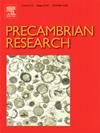Douling杂岩970-840 Ma岩浆记录:对扬子地块北部东期俯冲-增生和碰撞过程的认识
IF 3.2
2区 地球科学
Q2 GEOSCIENCES, MULTIDISCIPLINARY
引用次数: 0
摘要
东期俯冲-增生和碰撞记录是阐明扬子地块北部构造演化的基础。扬子地块北缘的双岭杂岩保存了重要的新元古代记录。然而,由于托尼期岩浆岩的暴露有限,这一时期的构造制度仍然不明确。在这篇文章中,我们介绍了来自Douling杂岩的角闪岩、云母片岩和片麻岩闪长岩-花岗闪长岩的新的年代学、地球化学和同位素数据。角闪岩产生的原岩年龄约为970 ~ 920 Ma,代表了在杜岭杂岩中发现的最早的新元古代岩浆事件。这些角闪岩具有拉斑岩的亲缘性,Th/Nb和Th/Zr比值较低,全岩ƐNd(t)值为+3.39 ~ + 5.12,锆石ƐHf(t)值为+3.8 ~ + 11.1,表明其为衰竭地幔源。ⅰ组(约920 Ma)具有E-MORB亲和力,TiO2含量较高,空间上与云母片岩相关,形成于与俯冲有关的弧后盆地;群II(约970 Ma)表现出N-MORB特征,TiO2含量较低,解释为海洋地壳残留物。麻质闪长岩/花岗闪长岩的年代约为850 ~ 840 Ma。约850 Ma麻质闪长岩具有LILE和LREE富集、HFSE亏缺、锆石ƐHf(t)值变化(-4.5 ~ + 7.7)的特征,表明锆石来源于具有回收成分的幼壳部分熔融。约840 Ma麻质花岗闪长岩具有钙碱性组成,低MgO、Ni和Cr浓度,高Sr/Y比值,具有ttg类亲和力。高负锆石ƐHf(t)值(-15.1 ~ -12.5)和新太古代TDM2模式年龄(2.51 ~ 2.67 Ga)表明太古宙大陆地壳在俯冲相关背景下发生了明显的改造。此外,无带锆石域中约821 ~ 813 Ma的角闪岩相变质作用,其特征为明显陡峭的ree模式,可忽略或略负的Eu异常,地层温度为611 ~ 714℃。结合扬子地块北部新元古代的区域资料,提出了在Tonian期沿碧口-小磨岭-杜岭缝合带发生了一系列的俯冲-增生和碰撞过程。本文章由计算机程序翻译,如有差异,请以英文原文为准。
970–840 Ma magmatic records from the Douling Complex: Insights into Tonian Subduction-Accretionary and collisional processes in the northern Yangtze Block
Tonian subduction-accretionary and collisional records are fundamental for elucidating the tectonic evolution of the northern Yangtze Block. The Douling Complex along the northern margin of the Yangtze Block preserves key Neoproterozoic records. However, due to the limited exposure of Tonian magmatic rocks, the tectonic regime during this period remains ambiguous. In this contribution, we present new geochronological, geochemical, and isotopic data from amphibolites, mica schists, and gneissic diorite–granodiorites from the Douling Complex. The amphibolites yield protolith ages of ca. 970–920 Ma, representing the earliest Neoproterozoic magmatic event identified in the Douling Complex. These amphibolites exhibit tholeiitic affinities, low Th/Nb and Th/Zr ratios, and positive whole-rock ƐNd(t) values (+3.39 to + 5.12) and zircon ƐHf(t) values (+3.8 to + 11.1), indicating a depleted mantle source. Two groups are distinguished: Group I (ca. 920 Ma) displays E-MORB affinities and higher TiO2 contents, and is spatially associated with mica schist, suggesting formation in a subduction-related back-arc basin; Group II (ca. 970 Ma) exhibits N-MORB signatures with lower TiO2 contents, interpreted as remnants of oceanic crust. The gneissic diorite/granodiorites are dated at ca. 850–840 Ma. The ca. 850 Ma gneissic diorites are characterized by LILE and LREE enrichments, HFSE depletions, and variable zircon ƐHf(t) values ranging from –4.5 to + 7.7, indicating derivation from partial melting of juvenile crust with recycled components. The ca. 840 Ma gneissic granodiorites exhibit calc-alkaline compositions, low MgO, Ni, and Cr concentrations, and high Sr/Y ratios with TTG-like affinities. Their highly negative zircon ƐHf(t) values (–15.1 to –12.5) and Neoarchean TDM2 model ages (2.51–2.67 Ga) imply significant reworking of Archean continental crust in a subduction-related setting. Additionally, amphibolite-facies metamorphism at ca. 821–813 Ma is recorded in unzoned zircon domains, characterized by pronouncedly steep HREE patterns, negligible or slightly negative Eu anomalies, and formation temperatures ranging from 611 to 714 °C. Combined with regional Neoproterozoic data from the northern Yangtze block, we propose a successive of subduction–accretionary and collisional processes occurred along the Bikou–Xiaomoling–Douling suture zone during the Tonian period.
求助全文
通过发布文献求助,成功后即可免费获取论文全文。
去求助
来源期刊

Precambrian Research
地学-地球科学综合
CiteScore
7.20
自引率
28.90%
发文量
325
审稿时长
12 months
期刊介绍:
Precambrian Research publishes studies on all aspects of the early stages of the composition, structure and evolution of the Earth and its planetary neighbours. With a focus on process-oriented and comparative studies, it covers, but is not restricted to, subjects such as:
(1) Chemical, biological, biochemical and cosmochemical evolution; the origin of life; the evolution of the oceans and atmosphere; the early fossil record; palaeobiology;
(2) Geochronology and isotope and elemental geochemistry;
(3) Precambrian mineral deposits;
(4) Geophysical aspects of the early Earth and Precambrian terrains;
(5) Nature, formation and evolution of the Precambrian lithosphere and mantle including magmatic, depositional, metamorphic and tectonic processes.
In addition, the editors particularly welcome integrated process-oriented studies that involve a combination of the above fields and comparative studies that demonstrate the effect of Precambrian evolution on Phanerozoic earth system processes.
Regional and localised studies of Precambrian phenomena are considered appropriate only when the detail and quality allow illustration of a wider process, or when significant gaps in basic knowledge of a particular area can be filled.
 求助内容:
求助内容: 应助结果提醒方式:
应助结果提醒方式:


